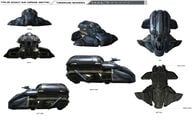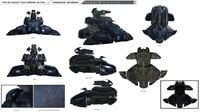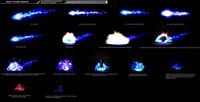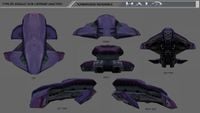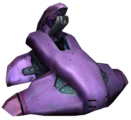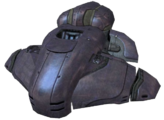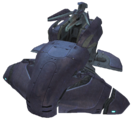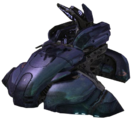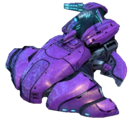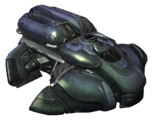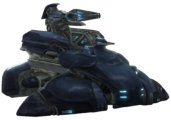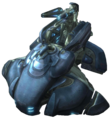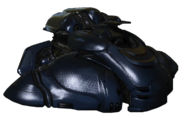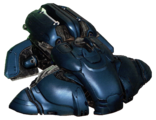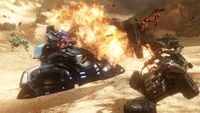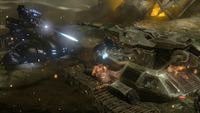Zurdo-pattern Wraith
From Halopedia, the Halo wiki
| This article does not meet the wiki's general standards and/or standards on layouts. You can help by cleaning this article. |
The Type-26 Assault Gun Carriage,[1] nicknamed the Wraith by the UNSC, is the Covenant's main heavy assault vehicle for ground engagements.
Specifications
Design details
The Type-26 Assault Gun Carriage is the primary armored ground vehicle used by the Covenant.[2] The Covenant deploys Wraiths in tactical ground engagements, where they serve in both anti-infantry and anti-armor roles. The Wraith's firepower also makes it ideal for destroying structures[3] in the way of ground forces attempting to advance in an area.
Like all Covenant ground vehicles, the Wraith is sleek, bulbous and more reminiscent of an aircraft than a traditional ground vehicle. The Wraith is divided into four main sections: chassis, fins, rudders, and plasma mortar. The chassis houses the cockpit, which includes movement, targeting and firing controls. Holographic control surfaces and displays show the pilot a 360-degree view outside the Wraith.[4] Underneath the cockpit is a boosted gravity propulsion drive[5], which propels the Wraith and keeps it suspended a short distance above the ground. The Wraith's engine vents excess heat and plasma through an exhaust port at the rear of the vehicle; this port is one of the more vulnerable spots on the Wraith. The wide, sweeping fins at the front of the vehicle stabilize the vehicle on uneven terrain, as well as provide extra thrust during a boost.[5] At the rear of the Wraith are two rudders, which control the turning of the vehicle using independent propulsion drives. The fourth major component is the Wraith's main weapon, a heavy plasma mortar, which rests above and behind the cockpit and can be retracted within the main body. The entirety of the Wraith is covered by nearly two feet of armor plating, which is composed of a polymer that is still poorly understood by human physicists.[1]
Armaments
The main weapon of the Wraith is its 35cm plasma mortar.[6] The Wraith's mortar is attached to a fixed mounting, meaning that a Wraith must be facing its target in order to hit it.[1] The plasma mortar works by creating a magnetically encapsulated blob of superheated plasma and firing it at a relatively low velocity. Once fired, the bolt is magnetically guided in a ballistic trajectory until it strikes the ground or target. When the bolt hits, the magnetic bubble collapses and the plasma rapidly expands from its compressed state, creating a superheated explosion that will vaporize everything within twenty meters of impact.[7] Titanium battleplate, concrete, or flesh is instantly obliterated by the blast. Anything just outside of the kill zone is at risk of injury or death — after the initial impact, the plasma begins to cool and thermal expansion takes over, creating a wave of fire traveling outward that can travel away from the initial blast zone. Infantry within range can sustain burns and heat trauma. The explosion also generates a large amount of concussive force, which can splinter bones and destroy vital organs.[8] Flammable materials are especially at risk of igniting due to the intense heat release and can cause further damage. Once the heat from the explosion dissipates, the blast zone will have been converted into a glass-smooth surface - much like the swaths of vitrified soil created by "glassing".
The Wraith is also equipped with an anti-infantry plasma turret. All Wraiths in service up to 2549 were equipped with two automated plasma cannons, while later models swapped these for extra-passenger space and a Type-52 DESW ring mount.[3][9] Both varieties of turret are able to burn through armor and flesh, with predictably gruesome results. Against infantry, the cannon's plasma causes severe fourth-degree burns.
Advantages
With the exception of the Scarab, the Wraith is the Covenant's most destructive mobile armor. Its huge bulk is well shielded from small arms fire, and it is resistant to medium explosive weapons. Its ability to be deployed with the aid of dropships makes insertions into battlefield fairly easy. Its plasma mortar can easily decimate infantry and vehicles alike, and its destructive powers are so well known to UNSC forces that the mere sight of one on the battlefield can induce psychological effects.[7]
Disadvantages
The Wraith's main disadvantage is its slow speed, due to the vehicle's massive weight. While the boost drive can propel the vehicle to moderately high speeds, the maneuverability of the vehicle is compromised — turning becomes difficult during a boost, and the momentum that is built from it makes it is possible for the vehicle to inadvertently plow through friendly forces, crash into and get lodged between stationary objects, or overshoot its mark and skate off of a cliff or into a body of water. The Wraith is also poorly suited for scaling inclines.
Like most tanks, the Wraith has a "dead area", a zone in which the plasma mortar cannot fire without risking damage to itself.[10] The slow speed and cumbersome nature of the Wraith makes it prone to boarding action — while the front of the tank is harder to board because of the plasma turret(s), the rear is highly susceptible to boarding. A small rotating cylinder exhaust port in the back is a vulnerable spot that, if hit with a medium explosive device or anti-material weapons fire, can damage the tank severely. The exposed gunner operating the Type-52 DESW is also an easy target for marksman and sniper fire.
Since its weaponry is designed to be used against non-mobile or low-mobility targets, and its weight and wide profile prevent it from maneuvering with any deal of speed and accuracy, the Wraith is a very soft target for high mobility vehicles, such as a Warthog or a Ghost, and is at a high risk of destruction against a vehicle with a much more accurate heavy weapon (such as the Scorpion with its linear-firing 90mm cannon).
Operational history
The Wraith has been in service to the Covenant for over a century,[11] and has served in countless engagements during the Human-Covenant War. After the retaking of Harvest in 2526 by Admiral Cole, the Covenant, attempting to scout and recover an artifact, deployed multiple Wraiths during the assault on Harvest.
Throughout the war the Covenant deployed Wraiths during ground campaigns against civilian and military targets. Wraiths would commonly target civilian evacuation transports still on the ground and platforms and structures leading to them, or would fire and kill large groups of civilians crowded together. In 2531 during the first assault on the colony world Arcadia, multiple Wraiths were used in this situation to kill panicking civilians attempting to flee the Covenant invasion. The tanks assisted in destroying structures and platforms holding civilians waiting for evacuation. In addition, the tanks were used against UNSC military forces attempting to assist with evacuation efforts. During the Battle of Shield World 0459 Wraiths were used by Covenant forces against not only the crew of the UNSC Spirit of Fire but also the Flood and Sentinels as well.
As the war dragged on, ground campaigns conducted by the Covenant continued to employ the Wraith as their main heavy armored vehicle. During the assault on Algolis the Wraiths were called in to weaken military forces attempting to protect and destroy valuable data. The UNSC was able to hold off the Covenant just long enough and all ground forces were eventually destroyed with the detonation of a nuclear weapon attached to a prototype armor suit.
As the war with humanity was reaching its apex, the Covenant began updating and building up their military campaign against humanity. A new model of the Wraith was introduced to help address some issues with older models. During the invasion of Sigma Octanus IV in July of 2552 the Covenant deployed numerous tanks to take out strategic areas on the planet including military bases and civilian structures. No sooner had that battle finished the Covenant launched a surprise assault on Reach, humanity's heavily fortified epicenter of military and economic power outside of Earth. Multiple divisions of Wraith tanks were employed to inflict mass casualties on civilian and military forces alike. Their campaign was successful destroying major military and civilian transports, structures and killing countless in the process.
However when the UNSC Pillar of Autumn escaped, many Covenant ships followed to discover Halo, with its discovery the Covenant rushed to destroy the human ship as fast as possible, however when the Autumn crash landed the Covenant was forced to land on the ring and hunt down the humans. During the campaign on Halo the Covenant deployed Wraith's to protect structures and destroy human encampments. Their campaign ultimately failed when Halo was destroyed by John-117.
During the opening of the Battle of Earth, the Solemn Penance managed to reach the city of New Mombasa. In the short but bloody campaign the Covenant was able to land armor and troops into the city, Wraiths quickly moved in to cut off civilian evacuation by the city's rail system. With civilians cut off the Covenant began systematically destroying anything they could before the Prophet of Regret's ship jumped out of New Mombasa destroying parts the city. In the aftermath of Regret's retreat the full scale invasion of Earth began, the Covenant laid waste to many parts of the planet and Wraiths were on the forefront of the ground assault.
As the Battle for Earth raged on SPARTAN-117 with the full support of the UNSC In Amber Clad launched a counter-strike against regret who had jumped to Installation 05. Wraiths were deployed in the same manner as they were on Installation 04, however with the threat of the UNSC attempting to stop regret the Covenant relied on more aggressive tactics against their enemy using Wraith's to do anything possible to stop the advance of SPARTAN-117. The subsequent outbreak of the Flood and internal conflict that consumed the Covenant, however, left all involved to fend for themselves, after the conclusion of the battle for Installation 05 the Covenant reorganized and made a final push offensive on Earth.
With the uncovering of the Portal, the Covenant moved all their troops and armor to prevent the UNSC military from getting close to it. They deployed Wraiths to dispatch military forces attempting to break through their formation. After the opening of the portal and the arrival at Installation 00 the Covenant deployed all their assets in a last ditch effort to stop humanity and activate the remaining Halo installations. Wraiths were front and center in this operation, although ultimately, lost to their human enemies.
During the post-war era several Wraiths were used by Merg Vol's Covenant faction during the Battle of Draetheus V. Many would be destroyed by both Spartans Sarah Palmer and Edward Davis with the help of the UNSC Marine Corps and UNSC Army.
Four years after the end of the Human-Covenant War, Jul 'Mdama's Covenant faction continued to use the Wraith. Multiple Wraiths were used in the attack on the UNSC Infinity's crash site. Several were later used in defense of the Forerunner particle cannons. Wraiths were also used during the Didact's Raid on Ivanoff Station in their attempt to secure the Composer, and were deployed to many sites across the interior of Requiem during the combat within the planet six months later.
Changes
Halo: Combat Evolved
Introduced in Halo: Combat Evolved, the Wraith tank first appears as a stationary scenery object on the level The Truth and Reconciliation inside a CCS-class battlecruiser, and then on Assault on the Control Room as an active vehicle, although the player is not able to drive the tank at all in the game. This version of the Wraith has no anti-personnel weapons, and the visual design encompasses a more purple color scheme then later versions, the mortar design is also different from other games looking more like a tube, rather than the plasma emitter itself. On Normal difficulty, the Wraith can survive about two to three direct rocket hits before being destroyed. While formidable, it is not without weaknesses. Wraiths can be flipped, knocking the Sangheili driver out of the vehicle and rendering it useless. Just like the Ghost in Halo: Combat Evolved, the Wraith floats noticeably higher above the ground than it does in subsequent games.
Halo 2
In Halo 2, the Wraith received a graphical overhaul and its color scheme is more of a blueish color and is now drivable by the player. In addition, the Wraith now has two weapons: the standard plasma mortar and two automated plasma cannons. However, the player cannot utilize these turrets themselves, meaning that the Wraith is somewhat less effective in the player's hands. The turrets auto-target any enemy within range, making boarding a Wraith more difficult. Additionally, when a player boards a Wraith, they must wait a few second delay before being able to fire the Wraith's plasma mortar. The Wraith also includes a boost drive, capable of tripling the tank's speed for about one second and requires five seconds to recharge. Though this can be used to travel faster, it is commonly used to run over enemies who are getting too close and is extremely effective due to the Wraiths reverse speed being identical to a Spartan's or an Elite's running speed.
Halo 3 and Halo 3: ODST
Two different versions of the Wraith appear in Halo 3. The regular T-26 seen in previous titles, and the new AA Wraith. New features include visible lights, increased speed and a more accurate line of fire. However, the exposed exhaust port represents an extremely vulnerable spot in the armor, making it possible for the first time to destroy a Wraith with melee attacks from behind the tank with no direct melee attacks to the driver. A strong hit to the core after removing its cover causes a violent chain reaction of explosions. The tank has a subtle greenish shine to it and an embedded latticework that glimmers in the light. The most dramatic design change added an exposed topside gunnery position with a 270° view, allowing for better defense against enemy infantry and boarders. Boarding is made more difficult in that now boarders have both a pilot, and gunner to kill before gaining control of the vehicle. The boost feature is no longer as effective taking longer for the vehicle to achieve its optimum boost speed, although having the same top speed as its Halo 2 counterpart, the tank has difficulty traversing high angles and its reversing capability is often inadequate. If boarded from behind or on the front of the cockpit the driver cannot exit the vehicle, another difference from the Halo 2 version.
Halo: Reach
The Wraith in Halo: Reach received a visual upgrade and is a much more green-blue in color, with a greater iridescent sheen, and a larger, more electrically charged shot. It appears to be much stronger in terms of firepower and armor, being able to destroy Scorpions in single accurate hits, and the arc of its shot is greatly reduced and is slightly faster, making it a far more deadly vehicle. However, its plasma turret now overheats like all turrets. The Wraith's plasma mortar can also be destroyed, rendering the Wraith useless. Grunts are now the main operators of the plasma turret in Campaign and Firefight, which greatly simplifies matters for players as they are much easier to kill than Halo 3's Brute gunners. Whenever a wraith is hit with a Plasma Pistol's EMP shot, the Wraith's plasma mortar will fold closed and be temporarily disabled. Because of the game's revamped physics engine, a Wraith boosting into other (smaller) vehicles will destroy them.
Halo 4
In Halo 4, the mortar arcs a lot more. They are also a red color, closely resembling the mortar shots fired by the Type-48 Revenant. Once again, Elites are often seen manning turrets. It is also impossible to hijack a Wraith by boarding it and pummeling the driver, as the Wraith itself will be destroyed in the process. Instead, one has to kill the driver through other means, such as with a Sniper Rifle or meleeing the driver after jumping on or getting in the gunner seat like in Halo: Reach.
Trivia

|
See our gameplay information related to Zurdo-pattern Wraith on its gameplay page. |

|
Browse more images in this article's gallery page. |
- It is wrongly stated in the Halo 2 manual that the player can shoot the Wraith's plasma cannons while driving; these are usable only by NPCs in gameplay. The Halo 3 manual claims that the Wraith features the aforementioned cannons, though they appear only in Halo 2.
- An abstract depiction of the Marathon logo is embedded in the Wraith's cockpit in Halo: Reach. Bungie limited their use of Marathon references in the game due to intellectual property concerns, as opposed to the logo's frequent appearances in the original trilogy.
- In Halo: Combat Evolved Anniversary, the Wraith's model was carried over from Halo: Reach with no changes. As such the T-52 plasma cannon is still mounted on top, though it is not usable. Conversely, the Scorpion tank's independently mounted machine gun was removed entirely, yet it was not moved to the main turret as expected.
- It is possible, though difficult, to hijack a Wraith by hopping in the mounted turret while an enemy is still inside of it, while not harming the Wraith. In Halo Reach and Halo 4, in Campaign, Firefight or Spartan Ops, respectively, if the player is able to get in the turret while an enemy NPC driver is still in, the driver will hop out and usually start shooting at the player, after which the player can dispatch the enemy with the turret and claim the Wraith for him/herself with it being undamaged, hopefully.
Gallery
- Concept-HCE-Wraith-Early.jpg
Early concept art of the Wraith for Halo: Combat Evolved.
An inactive Type-26 Wraith AGC in Halo 2.
An active Wraith as it appears in Halo 3, with its turret unoccupied.
The Wraith as it appears in Halo Wars.
The Honor Guard Wraith, available with the limited edition of Halo Wars.
Beta render of an inactive Wraith as it appears in Halo: Reach.
The Master Chief wielding a plasma grenade against a Wraith in Halo 4.
A Wraith battling an M808 Scorpion in Halo 4.
List of appearances
- Halo: The Fall of Reach (First appearance)
- Halo: Combat Evolved
- Halo: The Flood
- Halo: First Strike
- Halo 2
- Halo: Ghosts of Onyx
- Halo 3
- Halo: Uprising
- Halo Wars
- Halo 3: ODST
- Halo Legends
- Halo: Evolutions - Essential Tales of the Halo Universe
- Halo: Blood Line
- Halo: Reach
- Halo: Fall of Reach
- Halo: Combat Evolved Anniversary
- Halo: The Thursday War
- Halo 4
- Halo: Spartan Assault
- Halo: Escalation
- Halo 2 Anniversary
- Halo: Spartan Strike
Sources
- ^ a b c Cite error: Invalid
<ref>tag; no text was provided for refs namedENC - ^ Bungie.net Halo: Reach Ordnance Page
- ^ a b Halo 2: Special Collector's Edition Manual, page 17
- ^ Halo: First Strike page 113
- ^ a b Halo 2 Manual page 19
- ^ Halo: Reach Manual, page 9
- ^ a b Halo: First Strike, page 112
- ^ Halo: Evolutions, "Palace Hotel", page 351
- ^ Halo Waypoint: Halo: Reach Stats
- ^ Halo: The Flood page 184
- ^ Halo Legends The Duel

